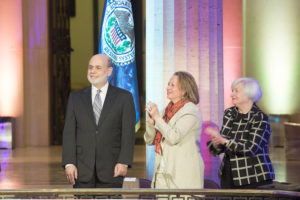
Chairman Ben S. Bernanke smiles alongside his wife, Anna, and Vice Chair Janet L. Yellen at a farewell reception held at the Marriner S. Eccles Federal Reserve Board Building in Washington, D.C. on January 30, 2014.
The Editors of the Wall Street Journal took a good long swing at the Nobel committee’s decision to award former Federal Reserve Chairman Ben Bernanke the prize in economics this year. Technically it was Bernanke’s research on the Great Depression that won him the Nobel, but as the Journal notes, it was also that research that convinced the Federal Reserve to keep rates lower for longer in 2003. The editors write:
An old joke has it that economists like to grouse that something may work in practice but does it work in theory? That comes to mind with the news that former Federal Reserve Chairman Ben Bernanke is sharing this year’s Nobel prize in economics for his research into financial crises. His insights worked in theory but not in practice.
Mr. Bernanke, Douglas Diamond and Philip Dybvig are sharing the Nobel for work adding to understanding of the relationship between banking crises and the broader economy. The assumption for much of the 20th century was that banking crises were a result of negative developments on Main Street or the farm.
The economists’ research in 1983 and ’84 showed how bank runs and collapses could be cause rather than effect, freezing the efficient allocation of capital and grinding Main Street to a halt. Mr. Bernanke observed that when a bank fails, its institutional insight into the creditworthiness of its borrowers is lost and is hard to replace. This, Mr. Bernanke posited, was a major reason the Great Depression became as deep as it did.
This research is important and could be useful to central bankers, except it didn’t help Mr. Bernanke when he was at the Federal Reserve in the 2000s and 2010s. It may have done the opposite. We’d argue now, as we argued at the time, that Mr. Bernanke and the Fed created the monetary conditions that led to the worst financial panic in 80 years.
As a Fed governor in 2002-2005, Mr. Bernanke made news by claiming the biggest economic risk was deflation. He persuaded his colleagues and Chairman Alan Greenspan to keep interest rates unusually low in spring 2003 even as a tax cut passed and the economy boomed. Asset prices soared, especially the housing market, but the Fed kept supplying a subsidy for credit with negative real interest rates.
As Mr. Bernanke’s research showed, the financial panic and crash that followed the asset mania sent the economy into recession. Mr. Bernanke took over as Fed chairman from 2006-2014. Yet the Fed failed to anticipate the financial panic and crash. Like many economists and most politicians, the Fed viewed financial stability as a matter of regulation while ignoring the incentives created by monetary policy.
In the official transcript of the May 9, 2007, Federal Open Market Committee meeting, Fed open market account manager Bill Dudley declared that “the market turbulence that began in earnest on February 27 is now a distant memory.” Within weeks, investment bank Bear Stearns had to bail out two of its hedge funds with exposure to subprime mortgages.
In the Jan. 29-30, 2008, FOMC transcript, there’s only a single passing reference to Bear Stearns, which blew up within weeks. The precedent of rescuing Bear Stearns in March 2008 contributed to complacency and then panic when investors realized the Fed couldn’t or wouldn’t do the same for Lehman Brothers six months later.
The Bernanke Fed has been heralded for its monetary policies during the financial panic, and some of those were necessary and valuable. But the impact of Fed policies on financial stability is far from the heroic tale Mr. Bernanke likes to tell. In the 2010s those policies didn’t ignite the inflation some critics predicted, but they also coincided with the slowest economic recovery in decades.
Suppressing interest rates to historic lows and flooding the economy with bank reserves via quantitative easing distorted markets for every form of credit in ways economists still don’t understand—and then the Fed did the same only more so when the pandemic hit in 2020. The long-term effects on financial stability are only now coming into view as Chairman Jerome Powell’s Fed fights the inflation it helped to ignite.
It’s falling to other economists, such as Claudio Borio and colleagues at the Bank for International Settlements, to try to understand how the financial super cycle the Fed and other central banks created affects financial stability and the Main Street economy. Let’s hope we don’t have to learn the hard way from another financial panic and crash.
Read more here.
